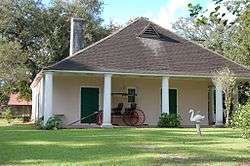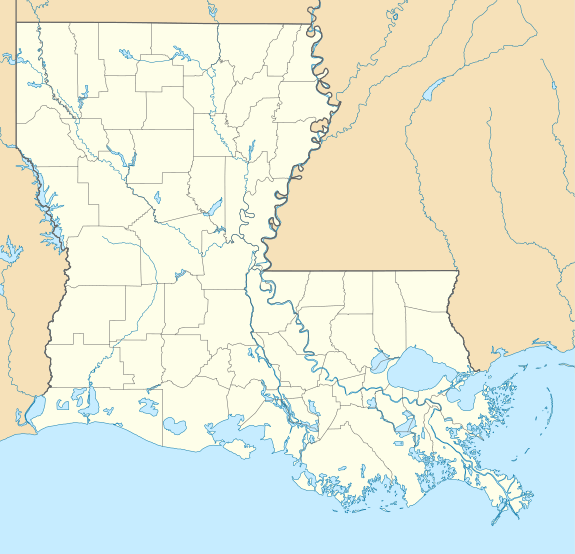LaBranche Plantation Dependency
The LaBranche Plantation Dependency House is located in St. Rose, St. Charles Parish, Louisiana. From many accounts, LaBranche Plantation in St. Rose, Louisiana, was one of the grandest on the German Coast until it was destroyed during the Civil War. All that remained was the dependency house, known as a garconnière (French for bachelor quarters).
LaBranche Plantation Dependency | |
 LaBranche Plantation Dependency | |
  | |
| Location | River Rd. (LA 48), St. Rose, Louisiana |
|---|---|
| Coordinates | 29°57′00″N 90°18′58″W |
| Built | 1792 |
| NRHP reference No. | 84000145 |
| Added to NRHP | October 18, 1984 |
.jpg)
History
The Zweig family, immigrants from Germany, acquired the property and built the plantation big house and related buildings in 1792. The main building was destroyed during the Civil War. Following the division of the property among heirs in the late 19th century, there is little left to indicate that a grand mansion stood on the grounds except for an allée lined with oak trees.[1]
The late eighteenth-nineteenth century Creole dependency house, typically used for young bachelors and known in French as a garconnière, is significant because of its Federal woodwork and rarity as a surviving plantation dependency. Olidé and Marie Perilloux Cambre purchased the dependency house and property in 1902.
Modern day
The site where the manor house once stood is on private land and is not accessible to the public. The site of the Dependency House is on land currently owned by the Lentini family of Kenner. The Lentinis purchased and restored the dependency house in 1983. On October 18, 1984, it was added to the National Register of Historic Places, due to its exquisite Federal woodwork and rarity as a plantation dependency or ancillary building.[2]
The property also has a preserved slave quarters building. It has been restored, to show the living conditions of a slave family (or families). Preserved slave quarters are few in the area, since most plantations were purchased by oil refineries or industrial plants for the property; any remaining slave housing was usually torn down.
Also located on the site is the bathtub owned by Zachary Taylor, the 12th President of the United States (1849–1850).[3]
See also
References
- "Archived copy". Archived from the original on 2012-10-28. Retrieved 2013-02-28.CS1 maint: archived copy as title (link) <--Broken link Sept. 2015] History of St. Charles Parish
- "Louisiana Plantation Homes", Experience New Orleans
External links
- Deceased LaBranche family members buried in St. Charles Parish on Find a Grave – there must be an historic connection between the family and the plantation.